Analyzing the Link Between Authentic Leadership, LMX, and PsyCap
VerifiedAdded on 2023/06/09
|13
|3629
|336
Essay
AI Summary
This essay provides a comprehensive literature review analyzing the relationship between authentic leadership, Leader-Member Exchange (LMX), and employees' Psychological Capital (PsyCap). It delves into how authentic leadership, characterized by self-awareness, unbiased processing, authentic behavior, and relational orientation, influences leader-member exchange dynamics and the psychological capital of employees. The study examines the components of PsyCap, including hope, optimism, resiliency, and self-efficacy, and how these factors contribute to employee performance. Furthermore, the review considers the impact of emotions on employee performance and explores how authentic leadership can be leveraged to build psychological capital among different types of employees, such as administrative versus professional, blue collar versus white collar, and those in emotional labor roles. The essay also touches upon the HERO model and the challenges organizations face in building an innovative and resilient environment through the development of psychological capital.
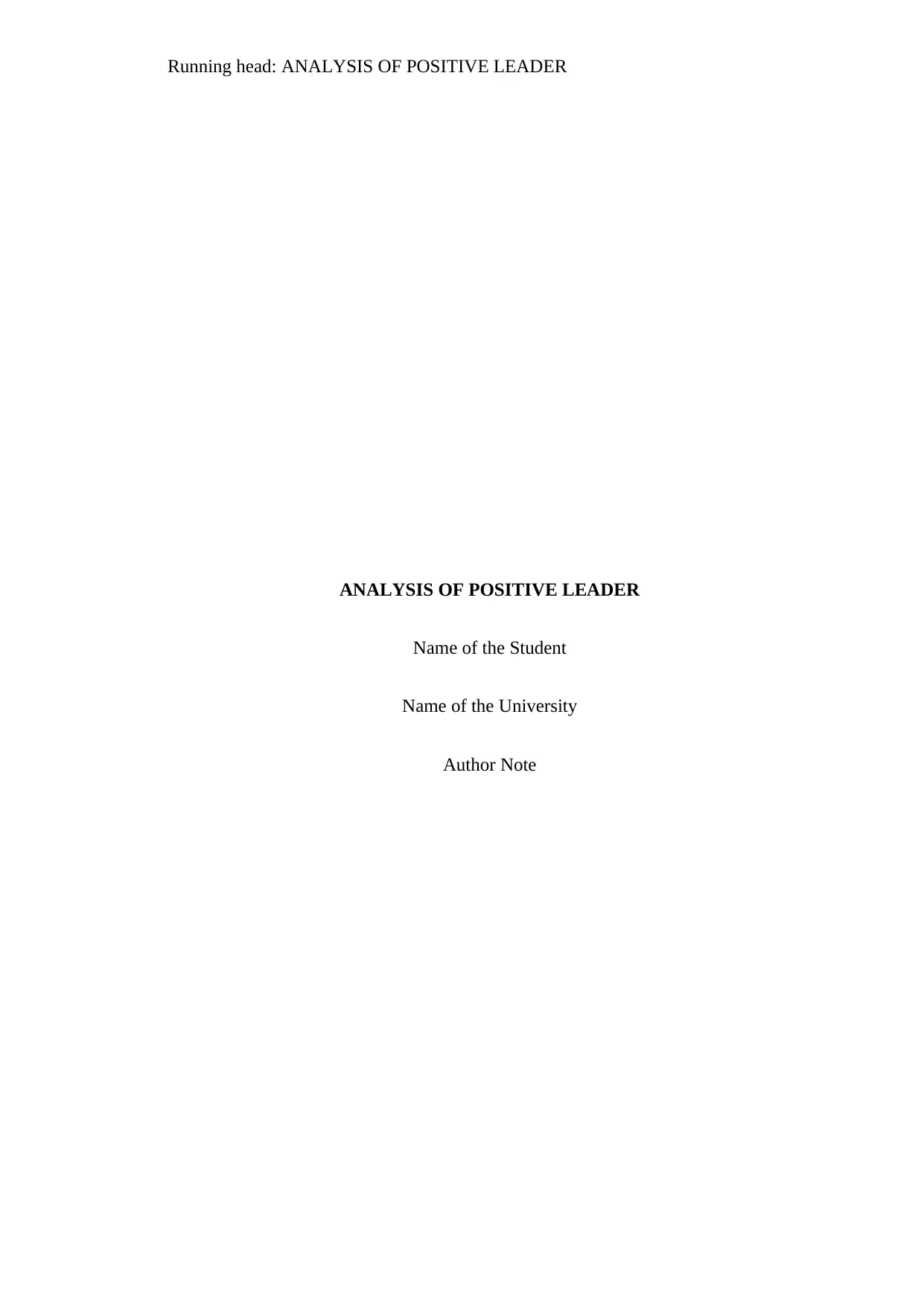
Running head: ANALYSIS OF POSITIVE LEADER
ANALYSIS OF POSITIVE LEADER
Name of the Student
Name of the University
Author Note
ANALYSIS OF POSITIVE LEADER
Name of the Student
Name of the University
Author Note
Paraphrase This Document
Need a fresh take? Get an instant paraphrase of this document with our AI Paraphraser
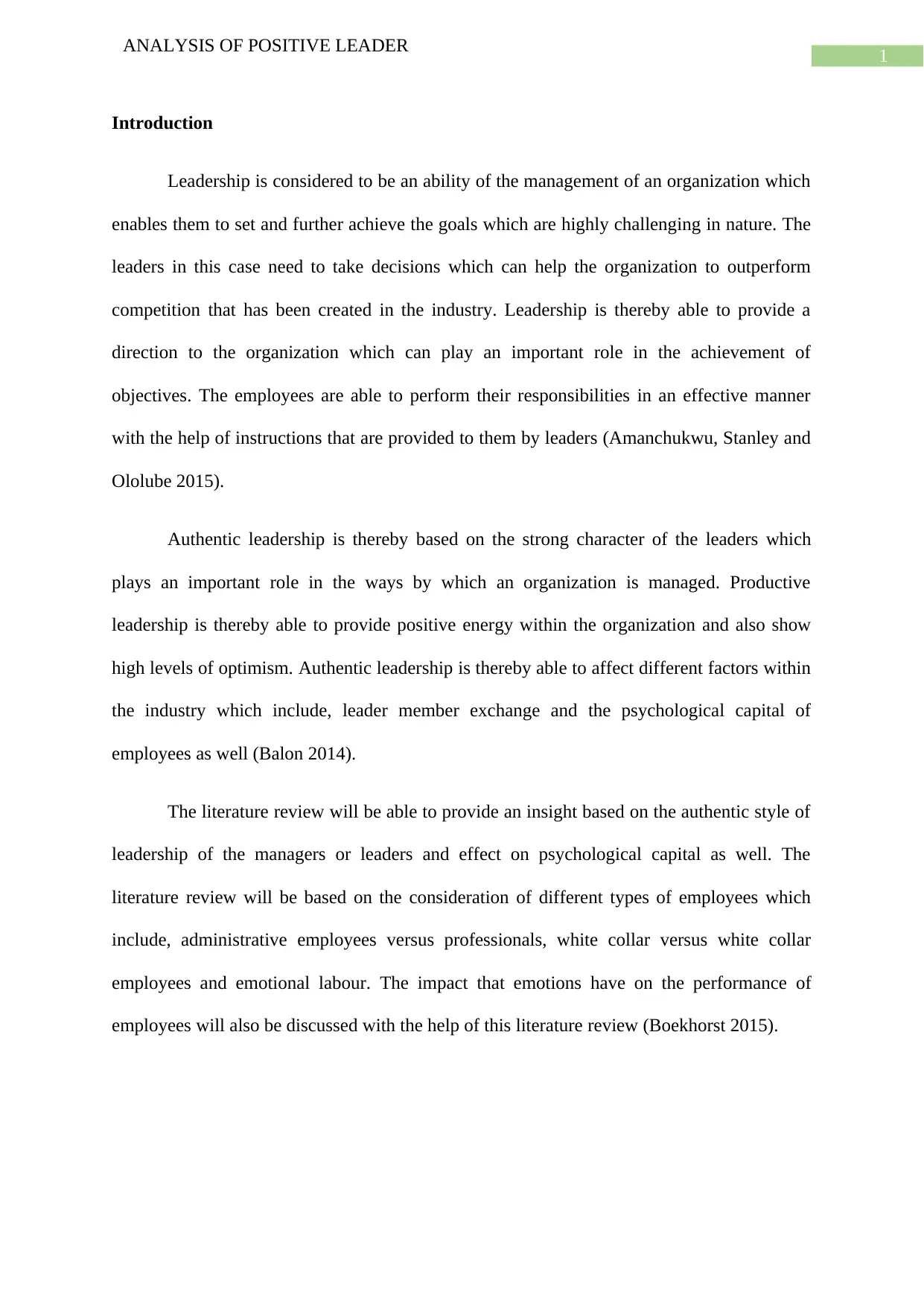
1
ANALYSIS OF POSITIVE LEADER
Introduction
Leadership is considered to be an ability of the management of an organization which
enables them to set and further achieve the goals which are highly challenging in nature. The
leaders in this case need to take decisions which can help the organization to outperform
competition that has been created in the industry. Leadership is thereby able to provide a
direction to the organization which can play an important role in the achievement of
objectives. The employees are able to perform their responsibilities in an effective manner
with the help of instructions that are provided to them by leaders (Amanchukwu, Stanley and
Ololube 2015).
Authentic leadership is thereby based on the strong character of the leaders which
plays an important role in the ways by which an organization is managed. Productive
leadership is thereby able to provide positive energy within the organization and also show
high levels of optimism. Authentic leadership is thereby able to affect different factors within
the industry which include, leader member exchange and the psychological capital of
employees as well (Balon 2014).
The literature review will be able to provide an insight based on the authentic style of
leadership of the managers or leaders and effect on psychological capital as well. The
literature review will be based on the consideration of different types of employees which
include, administrative employees versus professionals, white collar versus white collar
employees and emotional labour. The impact that emotions have on the performance of
employees will also be discussed with the help of this literature review (Boekhorst 2015).
ANALYSIS OF POSITIVE LEADER
Introduction
Leadership is considered to be an ability of the management of an organization which
enables them to set and further achieve the goals which are highly challenging in nature. The
leaders in this case need to take decisions which can help the organization to outperform
competition that has been created in the industry. Leadership is thereby able to provide a
direction to the organization which can play an important role in the achievement of
objectives. The employees are able to perform their responsibilities in an effective manner
with the help of instructions that are provided to them by leaders (Amanchukwu, Stanley and
Ololube 2015).
Authentic leadership is thereby based on the strong character of the leaders which
plays an important role in the ways by which an organization is managed. Productive
leadership is thereby able to provide positive energy within the organization and also show
high levels of optimism. Authentic leadership is thereby able to affect different factors within
the industry which include, leader member exchange and the psychological capital of
employees as well (Balon 2014).
The literature review will be able to provide an insight based on the authentic style of
leadership of the managers or leaders and effect on psychological capital as well. The
literature review will be based on the consideration of different types of employees which
include, administrative employees versus professionals, white collar versus white collar
employees and emotional labour. The impact that emotions have on the performance of
employees will also be discussed with the help of this literature review (Boekhorst 2015).

2
ANALYSIS OF POSITIVE LEADER
Conceptual framework of leadership and employee performance
Source – Created by author
Critical analysis of authentic leadership and psychological capital
The study mainly explores the emerging aspects of leadership which deals with the
different inner-self related aspects related to leadership. Authentic leadership is largely based
on transformational style of leadership and is related to the ability of the leaders so that the
follower can be encouraged and praised so that they are able to perform in a better way.
Transformation leadership is thereby investigated with the help of the analysis of leader’s
behaviour and their influence on the followers or employees. Authentic leadership can also
further help the leaders to make the employees go beyond their assigned responsibilities in
order to achieve in the industry (Bolden 2016).
According to, Cox (2016), traits that mainly originate from behaviour of a person and
their values are major areas of focus of authentic leadership. These qualities are able to equip
the leaders so that they are become capable of thinking about the ways by which they behave
which further affects the levels up to which some of them flourish and others don’t. The
authenticity of leadership style is based on the positivity of psychology. In the modern
organizations authentic leadership is based on the intrinsic qualities of leaders as compared to
Authentic
leadership
Leader-Member
Exchange LMX
PSYCHOLOGICAL
CAPITAL
ANALYSIS OF POSITIVE LEADER
Conceptual framework of leadership and employee performance
Source – Created by author
Critical analysis of authentic leadership and psychological capital
The study mainly explores the emerging aspects of leadership which deals with the
different inner-self related aspects related to leadership. Authentic leadership is largely based
on transformational style of leadership and is related to the ability of the leaders so that the
follower can be encouraged and praised so that they are able to perform in a better way.
Transformation leadership is thereby investigated with the help of the analysis of leader’s
behaviour and their influence on the followers or employees. Authentic leadership can also
further help the leaders to make the employees go beyond their assigned responsibilities in
order to achieve in the industry (Bolden 2016).
According to, Cox (2016), traits that mainly originate from behaviour of a person and
their values are major areas of focus of authentic leadership. These qualities are able to equip
the leaders so that they are become capable of thinking about the ways by which they behave
which further affects the levels up to which some of them flourish and others don’t. The
authenticity of leadership style is based on the positivity of psychology. In the modern
organizations authentic leadership is based on the intrinsic qualities of leaders as compared to
Authentic
leadership
Leader-Member
Exchange LMX
PSYCHOLOGICAL
CAPITAL
⊘ This is a preview!⊘
Do you want full access?
Subscribe today to unlock all pages.

Trusted by 1+ million students worldwide
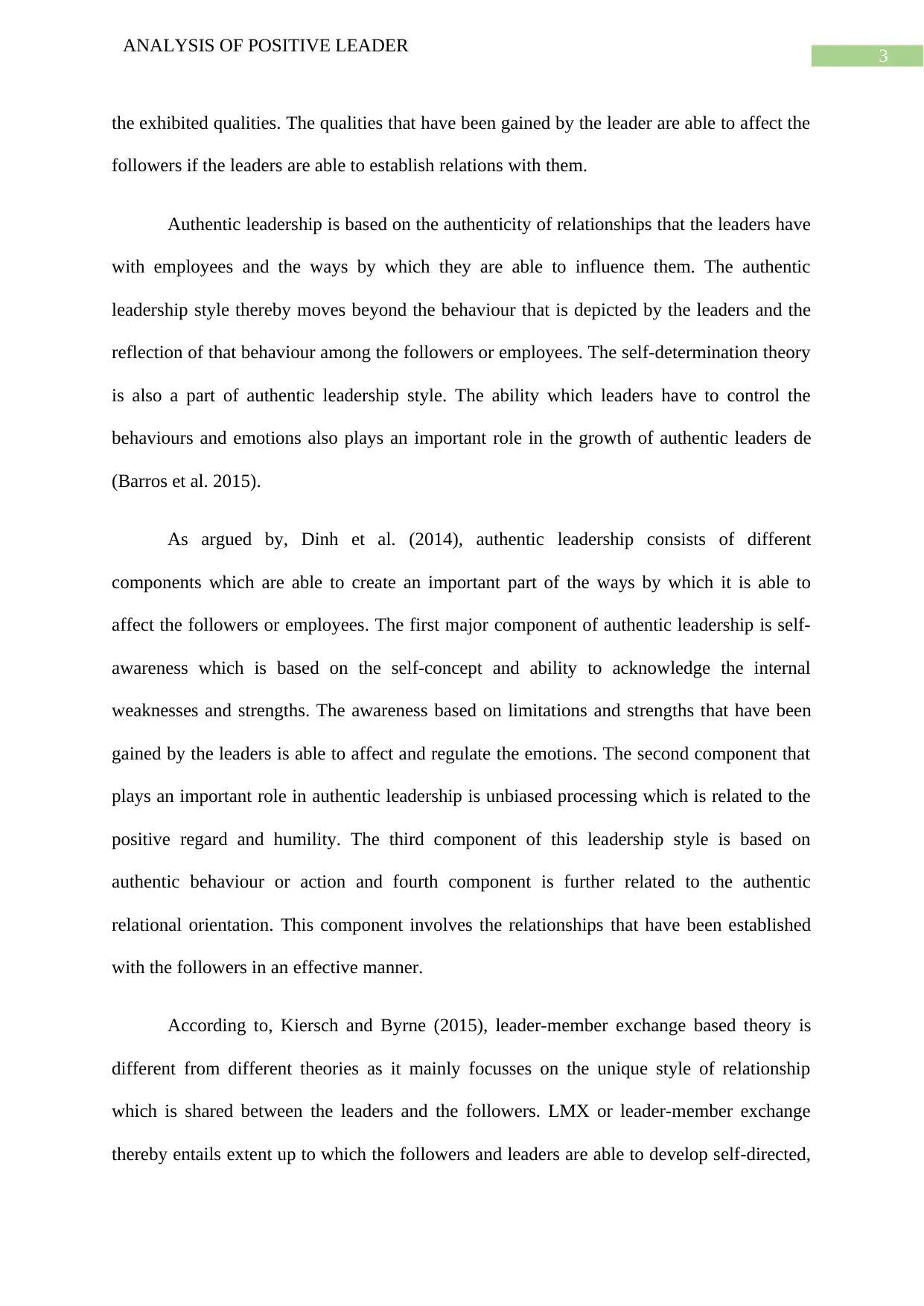
3
ANALYSIS OF POSITIVE LEADER
the exhibited qualities. The qualities that have been gained by the leader are able to affect the
followers if the leaders are able to establish relations with them.
Authentic leadership is based on the authenticity of relationships that the leaders have
with employees and the ways by which they are able to influence them. The authentic
leadership style thereby moves beyond the behaviour that is depicted by the leaders and the
reflection of that behaviour among the followers or employees. The self-determination theory
is also a part of authentic leadership style. The ability which leaders have to control the
behaviours and emotions also plays an important role in the growth of authentic leaders de
(Barros et al. 2015).
As argued by, Dinh et al. (2014), authentic leadership consists of different
components which are able to create an important part of the ways by which it is able to
affect the followers or employees. The first major component of authentic leadership is self-
awareness which is based on the self-concept and ability to acknowledge the internal
weaknesses and strengths. The awareness based on limitations and strengths that have been
gained by the leaders is able to affect and regulate the emotions. The second component that
plays an important role in authentic leadership is unbiased processing which is related to the
positive regard and humility. The third component of this leadership style is based on
authentic behaviour or action and fourth component is further related to the authentic
relational orientation. This component involves the relationships that have been established
with the followers in an effective manner.
According to, Kiersch and Byrne (2015), leader-member exchange based theory is
different from different theories as it mainly focusses on the unique style of relationship
which is shared between the leaders and the followers. LMX or leader-member exchange
thereby entails extent up to which the followers and leaders are able to develop self-directed,
ANALYSIS OF POSITIVE LEADER
the exhibited qualities. The qualities that have been gained by the leader are able to affect the
followers if the leaders are able to establish relations with them.
Authentic leadership is based on the authenticity of relationships that the leaders have
with employees and the ways by which they are able to influence them. The authentic
leadership style thereby moves beyond the behaviour that is depicted by the leaders and the
reflection of that behaviour among the followers or employees. The self-determination theory
is also a part of authentic leadership style. The ability which leaders have to control the
behaviours and emotions also plays an important role in the growth of authentic leaders de
(Barros et al. 2015).
As argued by, Dinh et al. (2014), authentic leadership consists of different
components which are able to create an important part of the ways by which it is able to
affect the followers or employees. The first major component of authentic leadership is self-
awareness which is based on the self-concept and ability to acknowledge the internal
weaknesses and strengths. The awareness based on limitations and strengths that have been
gained by the leaders is able to affect and regulate the emotions. The second component that
plays an important role in authentic leadership is unbiased processing which is related to the
positive regard and humility. The third component of this leadership style is based on
authentic behaviour or action and fourth component is further related to the authentic
relational orientation. This component involves the relationships that have been established
with the followers in an effective manner.
According to, Kiersch and Byrne (2015), leader-member exchange based theory is
different from different theories as it mainly focusses on the unique style of relationship
which is shared between the leaders and the followers. LMX or leader-member exchange
thereby entails extent up to which the followers and leaders are able to develop self-directed,
Paraphrase This Document
Need a fresh take? Get an instant paraphrase of this document with our AI Paraphraser
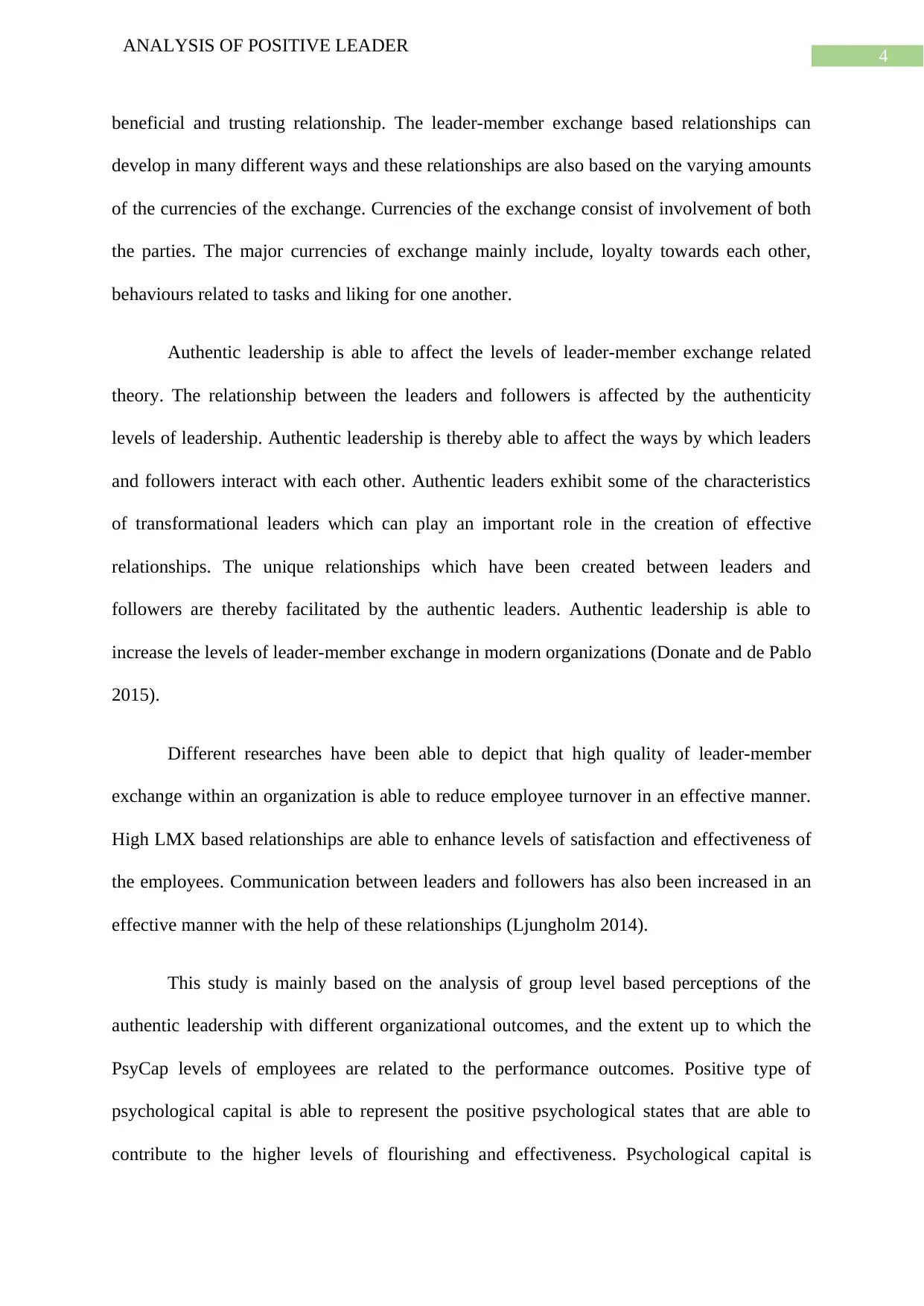
4
ANALYSIS OF POSITIVE LEADER
beneficial and trusting relationship. The leader-member exchange based relationships can
develop in many different ways and these relationships are also based on the varying amounts
of the currencies of the exchange. Currencies of the exchange consist of involvement of both
the parties. The major currencies of exchange mainly include, loyalty towards each other,
behaviours related to tasks and liking for one another.
Authentic leadership is able to affect the levels of leader-member exchange related
theory. The relationship between the leaders and followers is affected by the authenticity
levels of leadership. Authentic leadership is thereby able to affect the ways by which leaders
and followers interact with each other. Authentic leaders exhibit some of the characteristics
of transformational leaders which can play an important role in the creation of effective
relationships. The unique relationships which have been created between leaders and
followers are thereby facilitated by the authentic leaders. Authentic leadership is able to
increase the levels of leader-member exchange in modern organizations (Donate and de Pablo
2015).
Different researches have been able to depict that high quality of leader-member
exchange within an organization is able to reduce employee turnover in an effective manner.
High LMX based relationships are able to enhance levels of satisfaction and effectiveness of
the employees. Communication between leaders and followers has also been increased in an
effective manner with the help of these relationships (Ljungholm 2014).
This study is mainly based on the analysis of group level based perceptions of the
authentic leadership with different organizational outcomes, and the extent up to which the
PsyCap levels of employees are related to the performance outcomes. Positive type of
psychological capital is able to represent the positive psychological states that are able to
contribute to the higher levels of flourishing and effectiveness. Psychological capital is
ANALYSIS OF POSITIVE LEADER
beneficial and trusting relationship. The leader-member exchange based relationships can
develop in many different ways and these relationships are also based on the varying amounts
of the currencies of the exchange. Currencies of the exchange consist of involvement of both
the parties. The major currencies of exchange mainly include, loyalty towards each other,
behaviours related to tasks and liking for one another.
Authentic leadership is able to affect the levels of leader-member exchange related
theory. The relationship between the leaders and followers is affected by the authenticity
levels of leadership. Authentic leadership is thereby able to affect the ways by which leaders
and followers interact with each other. Authentic leaders exhibit some of the characteristics
of transformational leaders which can play an important role in the creation of effective
relationships. The unique relationships which have been created between leaders and
followers are thereby facilitated by the authentic leaders. Authentic leadership is able to
increase the levels of leader-member exchange in modern organizations (Donate and de Pablo
2015).
Different researches have been able to depict that high quality of leader-member
exchange within an organization is able to reduce employee turnover in an effective manner.
High LMX based relationships are able to enhance levels of satisfaction and effectiveness of
the employees. Communication between leaders and followers has also been increased in an
effective manner with the help of these relationships (Ljungholm 2014).
This study is mainly based on the analysis of group level based perceptions of the
authentic leadership with different organizational outcomes, and the extent up to which the
PsyCap levels of employees are related to the performance outcomes. Positive type of
psychological capital is able to represent the positive psychological states that are able to
contribute to the higher levels of flourishing and effectiveness. Psychological capital is

5
ANALYSIS OF POSITIVE LEADER
thereby considered to be a multidimensional type of construct and this concept is also able to
account for higher levels of variance so that outcomes can be predicted in an effective
manner (Edwards et al. 2015).
According to, Leroy et al. (2015), different factors which thereby need to be
considered for analysis of psychological capital mainly include, hope, optimism, resiliency,
self-efficacy and trust. These factors play an important role in the proper analysis of
psychological capital analysis of employees. Self-efficacy is related to the positive belief or
the levels of confidence in the ability of performing some specific tasks. Hope is based on
two major dimensions which include, pathways and will power. The will power of employees
is able to drive them towards the goal and the pathways are related to different courses of
action that are taken to accomplish the goals. Optimism can be explained as the positive style
of explain groups and individuals. Resiliency is based on the ability that has been possessed
by the employees or individuals so that they are able to come out from an adverse situation.
Resilience based factor of psychological capital is highly reactive in nature.
As argued by, Lyubovnikova et al. (2017), authentic leadership style is able to affect
the psychological capital that has been gained by the employees in an effective manner.
Authenticity of the leaders is based on the positive psychological capital that has been gained
by the employees. The levels of trust that is developed among the managers and followers
play an important role in the authenticity of leadership. The leaders who are able to remain
true to their values become more successful as compared to the others. Authentic leadership
is thereby able to affect the exchange that takes place among the leaders and followers. The
individual performance of the employees is affected by the authentic leadership style. The
group level performance of employees has also been influenced by the authentic leaders and
their ability to interact with them. Psychological capital is further able to improve the
authenticity of leadership.
ANALYSIS OF POSITIVE LEADER
thereby considered to be a multidimensional type of construct and this concept is also able to
account for higher levels of variance so that outcomes can be predicted in an effective
manner (Edwards et al. 2015).
According to, Leroy et al. (2015), different factors which thereby need to be
considered for analysis of psychological capital mainly include, hope, optimism, resiliency,
self-efficacy and trust. These factors play an important role in the proper analysis of
psychological capital analysis of employees. Self-efficacy is related to the positive belief or
the levels of confidence in the ability of performing some specific tasks. Hope is based on
two major dimensions which include, pathways and will power. The will power of employees
is able to drive them towards the goal and the pathways are related to different courses of
action that are taken to accomplish the goals. Optimism can be explained as the positive style
of explain groups and individuals. Resiliency is based on the ability that has been possessed
by the employees or individuals so that they are able to come out from an adverse situation.
Resilience based factor of psychological capital is highly reactive in nature.
As argued by, Lyubovnikova et al. (2017), authentic leadership style is able to affect
the psychological capital that has been gained by the employees in an effective manner.
Authenticity of the leaders is based on the positive psychological capital that has been gained
by the employees. The levels of trust that is developed among the managers and followers
play an important role in the authenticity of leadership. The leaders who are able to remain
true to their values become more successful as compared to the others. Authentic leadership
is thereby able to affect the exchange that takes place among the leaders and followers. The
individual performance of the employees is affected by the authentic leadership style. The
group level performance of employees has also been influenced by the authentic leaders and
their ability to interact with them. Psychological capital is further able to improve the
authenticity of leadership.
⊘ This is a preview!⊘
Do you want full access?
Subscribe today to unlock all pages.

Trusted by 1+ million students worldwide
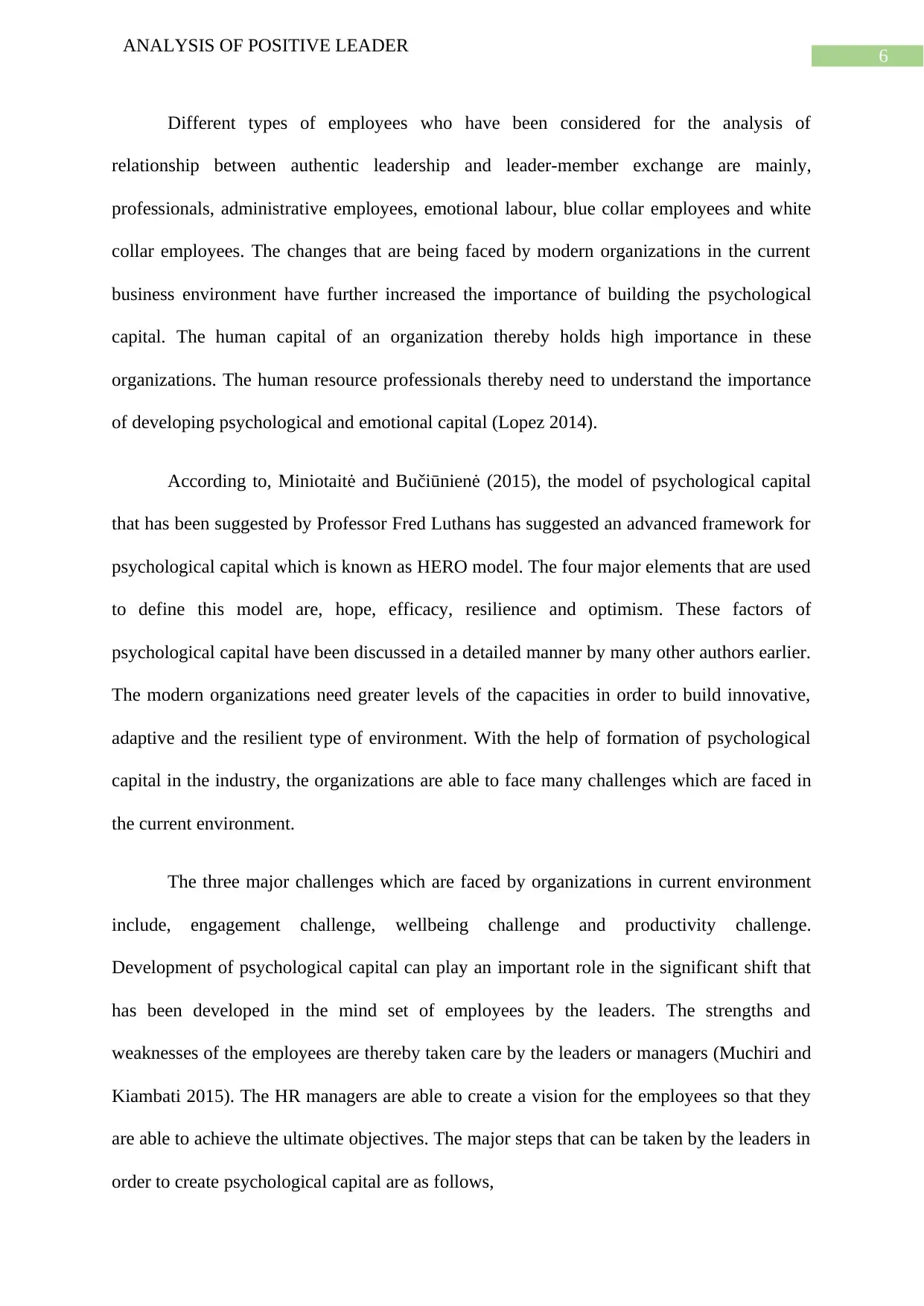
6
ANALYSIS OF POSITIVE LEADER
Different types of employees who have been considered for the analysis of
relationship between authentic leadership and leader-member exchange are mainly,
professionals, administrative employees, emotional labour, blue collar employees and white
collar employees. The changes that are being faced by modern organizations in the current
business environment have further increased the importance of building the psychological
capital. The human capital of an organization thereby holds high importance in these
organizations. The human resource professionals thereby need to understand the importance
of developing psychological and emotional capital (Lopez 2014).
According to, Miniotaitė and Bučiūnienė (2015), the model of psychological capital
that has been suggested by Professor Fred Luthans has suggested an advanced framework for
psychological capital which is known as HERO model. The four major elements that are used
to define this model are, hope, efficacy, resilience and optimism. These factors of
psychological capital have been discussed in a detailed manner by many other authors earlier.
The modern organizations need greater levels of the capacities in order to build innovative,
adaptive and the resilient type of environment. With the help of formation of psychological
capital in the industry, the organizations are able to face many challenges which are faced in
the current environment.
The three major challenges which are faced by organizations in current environment
include, engagement challenge, wellbeing challenge and productivity challenge.
Development of psychological capital can play an important role in the significant shift that
has been developed in the mind set of employees by the leaders. The strengths and
weaknesses of the employees are thereby taken care by the leaders or managers (Muchiri and
Kiambati 2015). The HR managers are able to create a vision for the employees so that they
are able to achieve the ultimate objectives. The major steps that can be taken by the leaders in
order to create psychological capital are as follows,
ANALYSIS OF POSITIVE LEADER
Different types of employees who have been considered for the analysis of
relationship between authentic leadership and leader-member exchange are mainly,
professionals, administrative employees, emotional labour, blue collar employees and white
collar employees. The changes that are being faced by modern organizations in the current
business environment have further increased the importance of building the psychological
capital. The human capital of an organization thereby holds high importance in these
organizations. The human resource professionals thereby need to understand the importance
of developing psychological and emotional capital (Lopez 2014).
According to, Miniotaitė and Bučiūnienė (2015), the model of psychological capital
that has been suggested by Professor Fred Luthans has suggested an advanced framework for
psychological capital which is known as HERO model. The four major elements that are used
to define this model are, hope, efficacy, resilience and optimism. These factors of
psychological capital have been discussed in a detailed manner by many other authors earlier.
The modern organizations need greater levels of the capacities in order to build innovative,
adaptive and the resilient type of environment. With the help of formation of psychological
capital in the industry, the organizations are able to face many challenges which are faced in
the current environment.
The three major challenges which are faced by organizations in current environment
include, engagement challenge, wellbeing challenge and productivity challenge.
Development of psychological capital can play an important role in the significant shift that
has been developed in the mind set of employees by the leaders. The strengths and
weaknesses of the employees are thereby taken care by the leaders or managers (Muchiri and
Kiambati 2015). The HR managers are able to create a vision for the employees so that they
are able to achieve the ultimate objectives. The major steps that can be taken by the leaders in
order to create psychological capital are as follows,
Paraphrase This Document
Need a fresh take? Get an instant paraphrase of this document with our AI Paraphraser

7
ANALYSIS OF POSITIVE LEADER
Step 1 - Building the sense based on the purpose that needs to be fulfilled by the
employees so that they are able to contribute to the vision in an effective manner. The
purpose needs to be developed in such a manner which helps the employees to work for the
benefit of the organization. The employees in this case feel that they have the ability to make
a difference in different systems (Norris 2017).
Step 2 - The managers need to focus on the positives so that they are able face
different challenges in the business environment. The response which is provided by
employees to different situations is able to provide a moment of truth to the company so that
the impact of their work process can be tested in an effective manner. The managers and
leaders need to make choices in a conscious manner to focus on the strengths, opportunities,
successes and threats. The emotions that are created due to different situations plays an
important role in the psychological capital that is developed (Paliszkiewicz, Gołuchowski and
Koohang 2015).
Step 3 - The employees need to prove their value in different work related processes
with the help of training that is provided to them. They need to be encouraged by the leaders
in such a manner which will help to go beyond the expectations of the company and provide
their services. This will help the leaders to build an optimistic attitude of the employees and
increase the levels of self-efficacy as well (Kiersch and Byrne 2015).
Step 4 - The empowerment that can be provided by the leaders to the managers is an
important factor that can be helpful in managing them on a personal basis and controlling
them as well. The company will thereby be able to build the psychological capital in such a
manner which can help in increasing organizational profitability to high levels. The leaders
have been able to recognise the importance of freeing up the strengths, energy and ideas of
ANALYSIS OF POSITIVE LEADER
Step 1 - Building the sense based on the purpose that needs to be fulfilled by the
employees so that they are able to contribute to the vision in an effective manner. The
purpose needs to be developed in such a manner which helps the employees to work for the
benefit of the organization. The employees in this case feel that they have the ability to make
a difference in different systems (Norris 2017).
Step 2 - The managers need to focus on the positives so that they are able face
different challenges in the business environment. The response which is provided by
employees to different situations is able to provide a moment of truth to the company so that
the impact of their work process can be tested in an effective manner. The managers and
leaders need to make choices in a conscious manner to focus on the strengths, opportunities,
successes and threats. The emotions that are created due to different situations plays an
important role in the psychological capital that is developed (Paliszkiewicz, Gołuchowski and
Koohang 2015).
Step 3 - The employees need to prove their value in different work related processes
with the help of training that is provided to them. They need to be encouraged by the leaders
in such a manner which will help to go beyond the expectations of the company and provide
their services. This will help the leaders to build an optimistic attitude of the employees and
increase the levels of self-efficacy as well (Kiersch and Byrne 2015).
Step 4 - The empowerment that can be provided by the leaders to the managers is an
important factor that can be helpful in managing them on a personal basis and controlling
them as well. The company will thereby be able to build the psychological capital in such a
manner which can help in increasing organizational profitability to high levels. The leaders
have been able to recognise the importance of freeing up the strengths, energy and ideas of
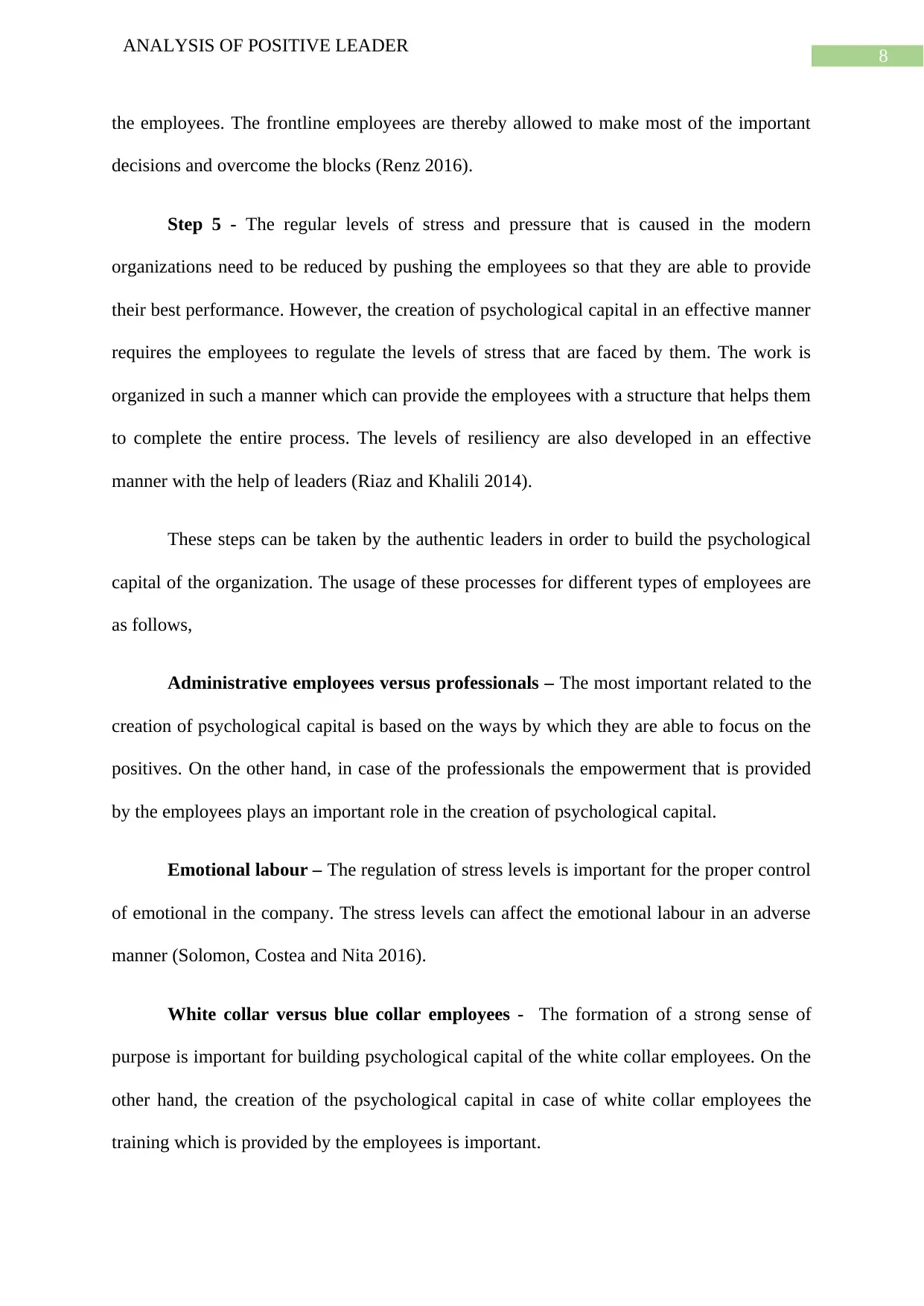
8
ANALYSIS OF POSITIVE LEADER
the employees. The frontline employees are thereby allowed to make most of the important
decisions and overcome the blocks (Renz 2016).
Step 5 - The regular levels of stress and pressure that is caused in the modern
organizations need to be reduced by pushing the employees so that they are able to provide
their best performance. However, the creation of psychological capital in an effective manner
requires the employees to regulate the levels of stress that are faced by them. The work is
organized in such a manner which can provide the employees with a structure that helps them
to complete the entire process. The levels of resiliency are also developed in an effective
manner with the help of leaders (Riaz and Khalili 2014).
These steps can be taken by the authentic leaders in order to build the psychological
capital of the organization. The usage of these processes for different types of employees are
as follows,
Administrative employees versus professionals – The most important related to the
creation of psychological capital is based on the ways by which they are able to focus on the
positives. On the other hand, in case of the professionals the empowerment that is provided
by the employees plays an important role in the creation of psychological capital.
Emotional labour – The regulation of stress levels is important for the proper control
of emotional in the company. The stress levels can affect the emotional labour in an adverse
manner (Solomon, Costea and Nita 2016).
White collar versus blue collar employees - The formation of a strong sense of
purpose is important for building psychological capital of the white collar employees. On the
other hand, the creation of the psychological capital in case of white collar employees the
training which is provided by the employees is important.
ANALYSIS OF POSITIVE LEADER
the employees. The frontline employees are thereby allowed to make most of the important
decisions and overcome the blocks (Renz 2016).
Step 5 - The regular levels of stress and pressure that is caused in the modern
organizations need to be reduced by pushing the employees so that they are able to provide
their best performance. However, the creation of psychological capital in an effective manner
requires the employees to regulate the levels of stress that are faced by them. The work is
organized in such a manner which can provide the employees with a structure that helps them
to complete the entire process. The levels of resiliency are also developed in an effective
manner with the help of leaders (Riaz and Khalili 2014).
These steps can be taken by the authentic leaders in order to build the psychological
capital of the organization. The usage of these processes for different types of employees are
as follows,
Administrative employees versus professionals – The most important related to the
creation of psychological capital is based on the ways by which they are able to focus on the
positives. On the other hand, in case of the professionals the empowerment that is provided
by the employees plays an important role in the creation of psychological capital.
Emotional labour – The regulation of stress levels is important for the proper control
of emotional in the company. The stress levels can affect the emotional labour in an adverse
manner (Solomon, Costea and Nita 2016).
White collar versus blue collar employees - The formation of a strong sense of
purpose is important for building psychological capital of the white collar employees. On the
other hand, the creation of the psychological capital in case of white collar employees the
training which is provided by the employees is important.
⊘ This is a preview!⊘
Do you want full access?
Subscribe today to unlock all pages.

Trusted by 1+ million students worldwide
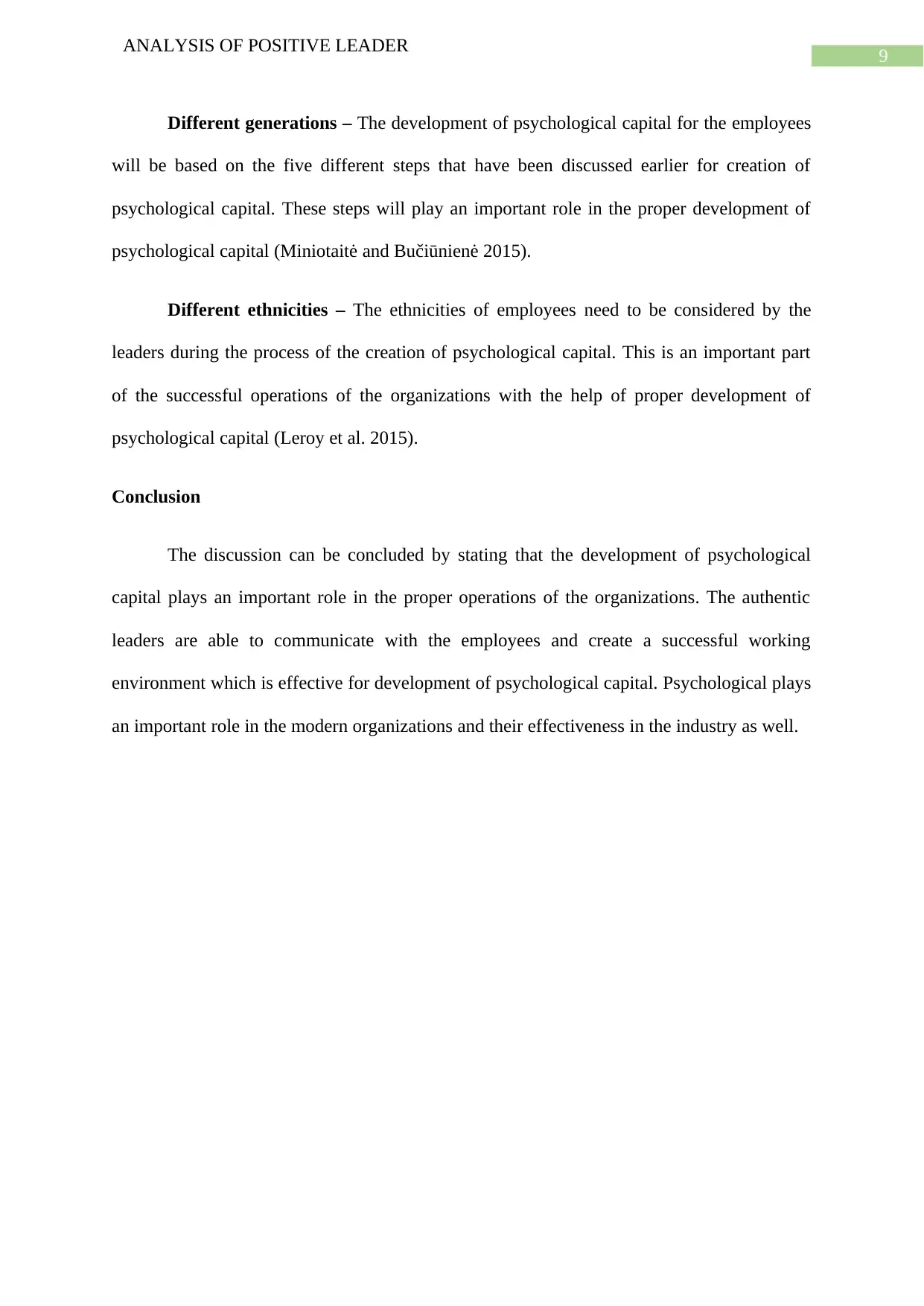
9
ANALYSIS OF POSITIVE LEADER
Different generations – The development of psychological capital for the employees
will be based on the five different steps that have been discussed earlier for creation of
psychological capital. These steps will play an important role in the proper development of
psychological capital (Miniotaitė and Bučiūnienė 2015).
Different ethnicities – The ethnicities of employees need to be considered by the
leaders during the process of the creation of psychological capital. This is an important part
of the successful operations of the organizations with the help of proper development of
psychological capital (Leroy et al. 2015).
Conclusion
The discussion can be concluded by stating that the development of psychological
capital plays an important role in the proper operations of the organizations. The authentic
leaders are able to communicate with the employees and create a successful working
environment which is effective for development of psychological capital. Psychological plays
an important role in the modern organizations and their effectiveness in the industry as well.
ANALYSIS OF POSITIVE LEADER
Different generations – The development of psychological capital for the employees
will be based on the five different steps that have been discussed earlier for creation of
psychological capital. These steps will play an important role in the proper development of
psychological capital (Miniotaitė and Bučiūnienė 2015).
Different ethnicities – The ethnicities of employees need to be considered by the
leaders during the process of the creation of psychological capital. This is an important part
of the successful operations of the organizations with the help of proper development of
psychological capital (Leroy et al. 2015).
Conclusion
The discussion can be concluded by stating that the development of psychological
capital plays an important role in the proper operations of the organizations. The authentic
leaders are able to communicate with the employees and create a successful working
environment which is effective for development of psychological capital. Psychological plays
an important role in the modern organizations and their effectiveness in the industry as well.
Paraphrase This Document
Need a fresh take? Get an instant paraphrase of this document with our AI Paraphraser

10
ANALYSIS OF POSITIVE LEADER
References
Amanchukwu, R.N., Stanley, G.J. and Ololube, N.P., 2015. A review of leadership theories,
principles and styles and their relevance to educational management. Management, 5(1),
pp.6-14.
Balon, R., 2014. Leadership versus management. Academic Psychiatry, 38(6), pp.720-722.
Boekhorst, J.A., 2015. The role of authentic leadership in fostering workplace inclusion: A
social information processing perspective. Human Resource Management, 54(2), pp.241-264.
Bolden, R., 2016. Leadership, management and organisational development. In Gower
handbook of leadership and management development (pp. 143-158). Routledge.
Cox, J.A., 2016. Leadership and Management Roles: Challenges and Success
Strategies. AORN journal, 104(2), pp.154-160.
de Barros, F.B., Goedegebuure, L., Meek, V.L. and Pettigrew, A., 2015. Institutional
governance, leadership and management of research for innovation and development. In The
Palgrave International Handbook of Higher Education Policy and Governance (pp. 261-
280). Palgrave Macmillan, London.
Dinh, J.E., Lord, R.G., Gardner, W.L., Meuser, J.D., Liden, R.C. and Hu, J., 2014.
Leadership theory and research in the new millennium: Current theoretical trends and
changing perspectives. The Leadership Quarterly, 25(1), pp.36-62.
Donate, M.J. and de Pablo, J.D.S., 2015. The role of knowledge-oriented leadership in
knowledge management practices and innovation. Journal of Business Research, 68(2),
pp.360-370.
ANALYSIS OF POSITIVE LEADER
References
Amanchukwu, R.N., Stanley, G.J. and Ololube, N.P., 2015. A review of leadership theories,
principles and styles and their relevance to educational management. Management, 5(1),
pp.6-14.
Balon, R., 2014. Leadership versus management. Academic Psychiatry, 38(6), pp.720-722.
Boekhorst, J.A., 2015. The role of authentic leadership in fostering workplace inclusion: A
social information processing perspective. Human Resource Management, 54(2), pp.241-264.
Bolden, R., 2016. Leadership, management and organisational development. In Gower
handbook of leadership and management development (pp. 143-158). Routledge.
Cox, J.A., 2016. Leadership and Management Roles: Challenges and Success
Strategies. AORN journal, 104(2), pp.154-160.
de Barros, F.B., Goedegebuure, L., Meek, V.L. and Pettigrew, A., 2015. Institutional
governance, leadership and management of research for innovation and development. In The
Palgrave International Handbook of Higher Education Policy and Governance (pp. 261-
280). Palgrave Macmillan, London.
Dinh, J.E., Lord, R.G., Gardner, W.L., Meuser, J.D., Liden, R.C. and Hu, J., 2014.
Leadership theory and research in the new millennium: Current theoretical trends and
changing perspectives. The Leadership Quarterly, 25(1), pp.36-62.
Donate, M.J. and de Pablo, J.D.S., 2015. The role of knowledge-oriented leadership in
knowledge management practices and innovation. Journal of Business Research, 68(2),
pp.360-370.

11
ANALYSIS OF POSITIVE LEADER
Edwards, G., Schedlitzki, D., Turnbull, S. & Gill, R., 2015. Exploring power assumptions in
the leadership and management debate. Leadership & Organization Development
Journal, 36(3), pp.328-343.
Kiersch, C.E. and Byrne, Z.S., 2015. Is being authentic being fair? Multilevel examination of
authentic leadership, justice, and employee outcomes. Journal of Leadership &
Organizational Studies, 22(3), pp.292-303.
Leroy, H., Anseel, F., Gardner, W.L. and Sels, L., 2015. Authentic leadership, authentic
followership, basic need satisfaction, and work role performance: A cross-level
study. Journal of Management, 41(6), pp.1677-1697.
Ljungholm, D.P., 2014. Transformational leadership behavior in public sector
organizations. Contemporary Readings in Law and Social Justice, 6(1), p.76.
Lopez, R., 2014. The relationship between leadership and management: Instructional
approaches and its connections to organizational growth. Journal of Business Studies
Quarterly, 6(1), p.98.
Lyubovnikova, J., Legood, A., Turner, N. and Mamakouka, A., 2017. How authentic
leadership influences team performance: The mediating role of team reflexivity. Journal of
business Ethics, 141(1), pp.59-70.
Miniotaitė, A. and Bučiūnienė, I., 2015. Explaining authentic leadership work outcomes from
the perspective of self-determination theory. Management of Organizations: Systematic
Research, (65), pp.63-75.
Muchiri, M. and Kiambati, K., 2015. Relating leadership processes, societal culture and
knowledge management: A theoretical model. Journal of Global Business Issues, 9(1), p.29.
ANALYSIS OF POSITIVE LEADER
Edwards, G., Schedlitzki, D., Turnbull, S. & Gill, R., 2015. Exploring power assumptions in
the leadership and management debate. Leadership & Organization Development
Journal, 36(3), pp.328-343.
Kiersch, C.E. and Byrne, Z.S., 2015. Is being authentic being fair? Multilevel examination of
authentic leadership, justice, and employee outcomes. Journal of Leadership &
Organizational Studies, 22(3), pp.292-303.
Leroy, H., Anseel, F., Gardner, W.L. and Sels, L., 2015. Authentic leadership, authentic
followership, basic need satisfaction, and work role performance: A cross-level
study. Journal of Management, 41(6), pp.1677-1697.
Ljungholm, D.P., 2014. Transformational leadership behavior in public sector
organizations. Contemporary Readings in Law and Social Justice, 6(1), p.76.
Lopez, R., 2014. The relationship between leadership and management: Instructional
approaches and its connections to organizational growth. Journal of Business Studies
Quarterly, 6(1), p.98.
Lyubovnikova, J., Legood, A., Turner, N. and Mamakouka, A., 2017. How authentic
leadership influences team performance: The mediating role of team reflexivity. Journal of
business Ethics, 141(1), pp.59-70.
Miniotaitė, A. and Bučiūnienė, I., 2015. Explaining authentic leadership work outcomes from
the perspective of self-determination theory. Management of Organizations: Systematic
Research, (65), pp.63-75.
Muchiri, M. and Kiambati, K., 2015. Relating leadership processes, societal culture and
knowledge management: A theoretical model. Journal of Global Business Issues, 9(1), p.29.
⊘ This is a preview!⊘
Do you want full access?
Subscribe today to unlock all pages.

Trusted by 1+ million students worldwide
1 out of 13
Related Documents
Your All-in-One AI-Powered Toolkit for Academic Success.
+13062052269
info@desklib.com
Available 24*7 on WhatsApp / Email
![[object Object]](/_next/static/media/star-bottom.7253800d.svg)
Unlock your academic potential
Copyright © 2020–2025 A2Z Services. All Rights Reserved. Developed and managed by ZUCOL.



